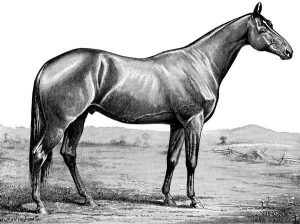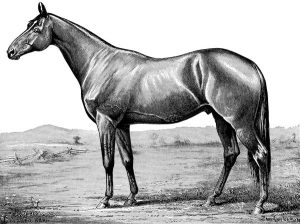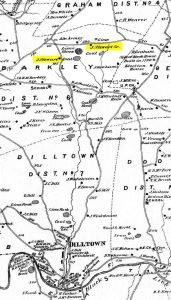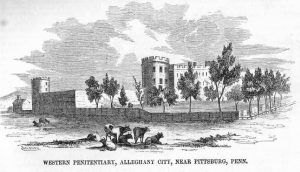
Is there a proverbial horse thief in your family tree? If you’re related to John Stewart (1821-1908), the answer is yes. John’s father was Major James Stewart, a well-respected member of the community, who served in the militia over forty years and was an elder of his church. He was also school director, tax collector, assessor, overseer of the poor, and justice of the peace.1,2
John’s grandfather was the Scottish immigrant John Stewart, who settled in the early 1790s in what would become Buffington Township, Indiana County, Pennsylvania. John inherited a portion of his grandfather’s land, 80 acres, which he farmed with his wife Sarah Jane Grow. In an 1871 map of Buffington Township, their home is likely marked J. Stewart north of Dilltown.3 John’s father Maj. James Stewart likely owned the farm marked J. Stewart, Sr. and John’s brother James either managed that farm and/or owned the land immediately to the south.
John and Sarah had fourteen children together, two of whom may have died as youngsters. He had at times the important job of transporting election results for the township.
Even with a large farm, a proud family heritage, and a dozen children, John turned to a life of crime, and at times, violence. In the summer of 1875 he attacked his wife Sarah with an ax.4 She survived, but John eluded capture for several weeks. He was captured in September and charged with assault and battery against Sarah. But, he brought charges of his own against two of his sons, among others, for the same incident.5 John and Sarah’s marriage was rocky. In the spring of 1876, John had the audacity to published a notice stating he was not responsible for his wife’s debts because she left his “bed and board without cause.”6
In August 1877, John was charged with stealing a horse from his neighbor Adam De Armey.7 He was later arrested in Somerset County, extradited, and quickly tried and found guilty. He was sentenced to one year and seven months labor in solitary confinement at the Western Penitentiary in Pittsburgh, and ordered to pay $150 in costs.8 He entered the penitentiary on September 17, 1877 and reported he had twelve children.9 Apparently he feigned illness upon his arrival in order to gain sympathy. A doctor saw him and after a “vigorous stirring up,” he quickly recovered.10
Unfortunately for Sarah Stewart and her children, the Sheriff was ordered to sell their farm and home to cover John’s fine and restitution.11 That portion of the original Stewart homestead was thus sold in December 1877 for just $300.12
In April 1883 John Stewart had spent time in jail at Johnstown for some offense. He later threatened to maim the newspaper editor there for his description of the incident. After leaving Johnstown the “noted tramp” came to Indiana, Pennsylvania, where he again spent two days in jail.13
By the fall of 1883, John was at it again. “Stewart is a notorious character and a bad man,” wrote the newspaper editor.14 Details are incomplete and somewhat confusing, but someone stole a colt from John McClaren in nearby Brush Valley. Mr. McClaren went searching for it and learned someone was seen with the colt and a white pony with a missing tooth. McClaren eventually came upon John Stewart and one of his sons, and they had a white pony. When McClaren tried to take possession of the pony as evidence, John threw stones at him. McClaren was injured and took out his revolver and shot Stewart twice. Stewart then fled and eluded capture for several days.15

A rumor circulated that John Stewart’s body had been found in the woods along with the dead colt. That was untrue.16 McLaren continued to look for his colt and discovered Stewart had sold it to a son of Charles W. Clovin at Shellsburg, Pennsylvania in Bedford County, three counties away.17 After proving he was the rightful owner, McClaren got his colt back. Clovin also received his white pony, which had been kept in escrow at Mechanicsburg.
Later Clovin’s sons heard Stewart was still in the area near Shellsburg and tracked him down. They succeeded in capturing him at nightfall, and recovered the pony’s saddle and bridle. As they led him back to the authorities, Stewart jumped off his horse and disappeared into the woods.18 He was captured some days later. By December, he was indicted for horse theft, but he was not arrested.19 It is possible he made restitution and avoided another prison term.
John and Sarah separated at some point, probably before 1877. They are perhaps listed in separate households in the 1880 census, John as a laborer and Sarah as a servant. However it is difficult to confirm their identities with certainty. By 1900 John was listed in the census living with his oldest son James Stewart and their family in Dilltown, Pennsylvania. He subsequently died at Blair, Pennsylvania January 18, 1908.
Sarah had moved to Johnstown, Pennsylvania, presumably to be near a few of her children and their families. She then moved to Homestead, Pennsylvania, also near a few of her children. She died there May 18, 1905.
Footnotes- C. T. Arms and E. White, History of Indiana County Pennsylvania 1745-1880 (Newark, Ohio: John Alexander Caldwell, 1880), Page 541, Major James Stewart.
- Joshua Thompson Stewart, Indiana County, Pennsylvania: Her People, Past and Present, 2 Volumes (Chicago, Illinois: J. H. Beers, 1913), Volume I, Pages 703, 706-707.
- State and County Maps: Pennsylvania: County Maps and Atlases, images, USGenWeb Archives, United States Digital Map Library (http://www.usgwarchives.org/maps/pa/county/: downloaded 9 December 2009), Map of Buffington Township, Indiana, Pennsylvania; citing Atlas of Indiana County Pennsylvania, (New York: F.W. Beers & Co., 1871).
- Pittsburgh Daily Commercial, 17 Jul 1875, page 4.
- Indiana [Pennsylvania] Democrat, 23 Sep 1875, page 3.
- Indiana [Pennsylvania] Progress, 2 Mar 1876, page 12.
- Indiana [Pennsylvania] Democrat, 16 Aug 1877, page 7.
- Indiana [Pennsylvania] Democrat, 20 Sep 1877, pages 3, 7, and 13.
- Pennsylvania, Prison, Reformatory, and Workhouse Records, 1829-1971 [database on-line]. (Lehi, UT, USA: Ancestry.com Operations, Inc., 2016), John Stewart, age 56, 17 September 1877, number 5590, page 215.
- Indiana [Pennsylvania] Democrat, 20 Sep 1877, page 7.
- Indiana [Pennsylvania] Progress, 22 Nov 1877, page 12.
- Indiana [Pennsylvania] Progress, 13 Dec 1877, page 5.
- Indiana [Pennsylvania] Weekly Messenger, 2 May 1883, page 7. The property was bounded on the north by land of James Stewart, probably John’s father, on the east by James Stewart, probably John’s brother, on the south by N. Altemus and others, and on the west by J. and R. M. Barkley. These names are shown on the 1871 map. Other evidence proves this was the homestead of the original settler, John Stewart, who deeded it in 1832 to his grandsons John and James in trust.
- Indiana [Pennsylvania] Democrat, 1 Nov 1883, page 3.
- Indiana [Pennsylvania] Democrat, 1 Nov 1883, page 3.
- Indiana [Pennsylvania] Progress, 22 Nov 1883, page 3.
- Indiana [Pennsylvania] Democrat, 15 Nov 1883, page 7.
- Indiana [Pennsylvania] Weekly Messenger, 21 Nov 1883, page 6, and Indiana [Pennsylvania] Progress, 22 Nov 1883, page 3.
- Indiana [Pennsylvania] Democrat, 6 Dec 1883, page 3.


